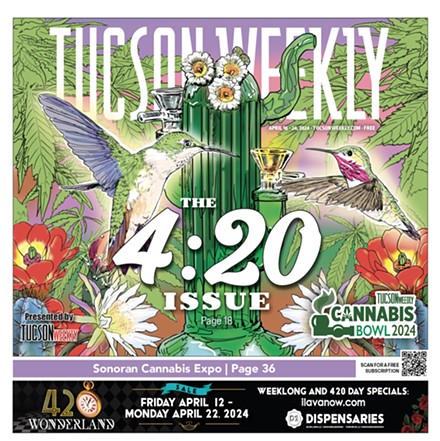For thousands of years, humans in the Southwest have created art to express their experiences and imaginations. These practices were developed and passed down for generations, and they still persist today. These include weaving, pottery making, Native American songs and storytelling. But traditional artists are often overlooked in the modern art world.
“The traditional arts tend to fly under the radar, yet they are the foundation of entire communities,” said Maribel Alvarez, a local anthropologist, folklorist and program director of the Tucson Meet Yourself festival.
Alvarez will receive the 2021 Shelley Award this year for her life’s work elevating the voices and creations of traditional artists. She will be virtually presented with the award at the 40th annual Governor’s Arts Awards, an event put on by Arizona Citizens for the Arts in partnership with Gov. Doug Ducey’s office.
Since 2006, the Shelley Award has been granted to an Arizonan who advances art and culture through innovation and advocacy. In her many roles, Alvarez has challenged the art community to recognize the work of folk and heritage artists and created platforms for these artists to express their stories.
She currently serves as the Jim Griffith chair in public folklore at the University of Arizona’s Southwest Center, the associate dean for community engagement in UA’s College of Social and Behavioral Sciences, and the program director of Tucson Meet Yourself, an annual folklife festive that celebrates traditional artists.
“Maribel’s commitment and passion ensures that important Native arts and cultural traditions are celebrated and embraced as everyday expressions of culture, heritage and diversity in the Southwest,” said Joseph Benesh, executive director of AzCA in a press release.
Alvarez was first “bit by the bug of culture and art” when she moved to San Jose after pursuing a bachelor’s and a master’s degree in political science at California State University Long Beach. She joined a poetry group and started participating in events created to represent artists of color.
During that time, Alvarez began to notice the inequities entrenched in the art community. Available funding for the arts was usually only given to established institutions, like symphonies and ballet companies, while other forms of art were overlooked.
Alvarez quickly became an advocate for underrepresented artists. In 1989, she helped found Movimiento de Arte y Cultura Latino Americana, a Latino art space in San Jose that seeks to use art as a catalyst for social change.
Alvarez moved to Tucson in 1993 to pursue a Ph.D. in anthropology and fell in love with the desert and the diversity of cultures that exist here.
“Once you come to Tucson, the world of art and culture opens up in big ways—as big as the landscape,” Alvarez said.
In Tucson, she was able to blend her intellectual curiosities with her passion for art and activism. She attempted to understand how we put together our human experience in her graduate program while also doing hands-on work with artisans in the community.
“That became a laboratory for me to really get to know Arizona and the people and to really feel connected to the region through the arts,” Alvarez said.
In 2004, she took a job with the Southwest Center to become the university folklorist and began to dive deeper into the world of community art. She made it her purpose to create space for traditional artists—from Navajo weavers to Tohono O’odham potters to Mexican American mariachi players—through fundraising and curation.
Throughout the pandemic, Alverez has continued to pursue her mission of expansion and amplification through creative new methods.
In October 2020, she spearheaded the creation of a “reframed” Tucson Meet Yourself event in partnership with the Southwest Folklife Alliance. The event celebrated traditional artists through virtual performances, a drive-in concert, a cruise for healing, a folk-art marketplace and a food pick-up event that embraced a longtime nickname of Tucson Meet Yourself: “Tucson Eat Yourself.”
While the 2020 event was not as large as previous Tucson Meet Yourself festivals, which drew more than 150,000 attendees annually, it still gave the community a safe way to celebrate a variety of cultures during a time of isolation.
Alvarez currently lives in Tucson with her wife and her two daughters. She dreams of the day when festivals can safely bloom again, but she also hopes to carry the lessons she’s learned from the pandemic into her work in the future. Her goal for Tucson Meet Yourself 2021 is to focus on quality over quantity.
“For the last 25 years, I have never written a poem because my work, my poetry, has become the crafting of ways in which people can connect and do their own thing,” Alvarez said. “I like to be the architect of the structure and then let other people shine.”









